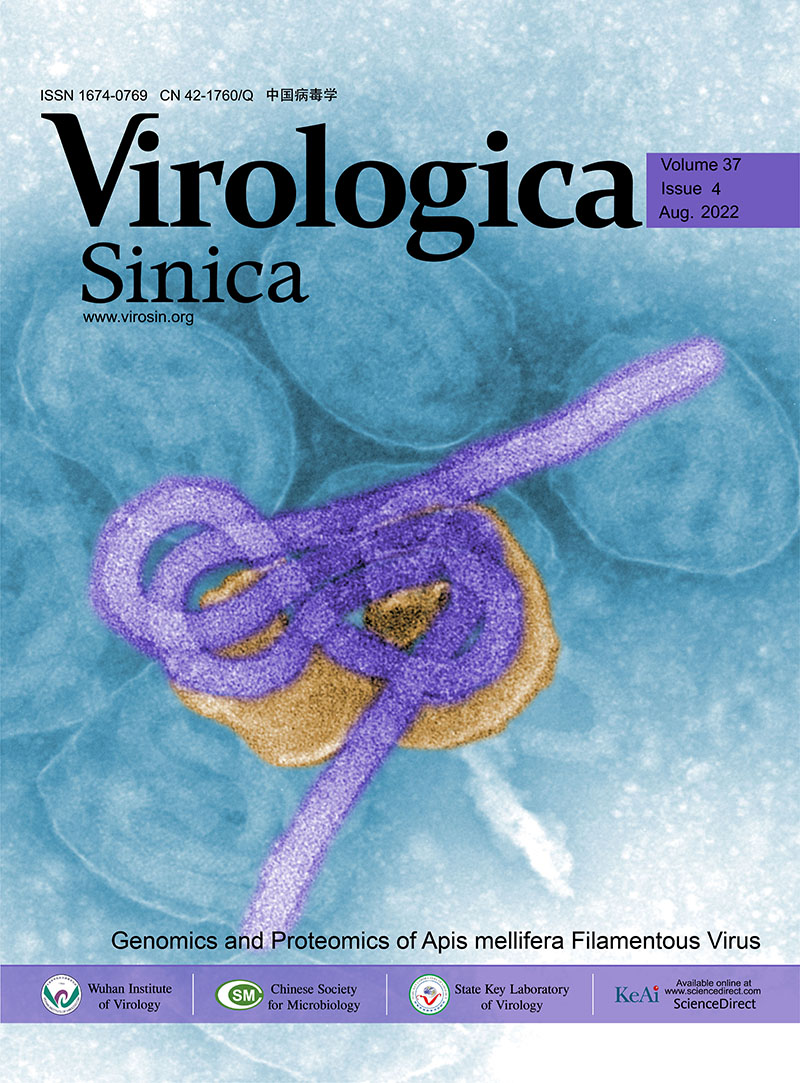-
Beaton, A.R., Rodriguez, J., Reddy, Y.K., Roy, P., 2002. The membrane trafficking protein calpactin forms a complex with bluetongue virus protein NS3 and mediates virus release. Proc. Natl. Acad. Sci. U. S. A. 99, 13154–13159.
-
Dai, L., Bai, L., Lin, Z., Qiao, J., Yang, L., Flemington, E.K., Zabaleta, J., Qin, Z., 2016.Transcriptomic analysis of KSHV-infected primary oral fibroblasts: the role of interferon-induced genes in the latency of oncogenic virus. Oncotarget 7, 47052–47060.
-
Degols, G., Eldin, P., Mechti, N., 2007. ISG20, an actor of the innate immune response.Biochimie 89, 831–835.
-
Du, J., Xing, S., Tian, Z., Gao, S., Xie, J., Chang, H., Liu, G., Luo, J., Yin, H., 2016.Proteomic analysis of sheep primary testicular cells infected with bluetongue virus.Proteomics 16, 1499–1514.
-
Espert, L., Degols, G., Gongora, C., Blondel, D., Williams, B.R., Silverman, R.H., Mechti, N., 2003. ISG20, a new interferon-induced RNase specific for single-stranded RNA, defines an alternative antiviral pathway against RNA genomic viruses. J. Biol.Chem. 278, 16151–16158.
-
Espert, L., Degols, G., Lin, Y.L., Vincent, T., Benkirane, M., Mechti, N., 2005. Interferoninduced exonuclease ISG20 exhibits an antiviral activity against human immunodeficiency virus type 1. J. Gen. Virol. 86, 2221–2229.
-
Gongora, C., David, G., Pintard, L., Tissot, C., Hua, T.D., Dejean, A., Mechti, N., 1997.Molecular cloning of a new interferon-induced PML nuclear body-associated protein.J. Biol. Chem. 272, 19457–19463.
-
Hao, Y., Yang, D., 2008. Cloning, eukaryotic expression of human ISG20 and preliminary study on the effect of its anti-HBV. J. Huazhong Univ. Sci. Technol. Med. Sci. 28, 11–13.
-
Hilke, J., Strobel, H., Woelke, S., Stoeter, M., Voigt, K., Moeller, B., Bastian, M., Ganter, M., 2019. Presence of antibodies against bluetongue virus (BTV) in sheep 5 to 7.5 Years after vaccination with inactivated BTV-8 vaccines. Viruses 11, 533.
-
Jiang, D., Guo, H., Xu, C., Chang, J., Gu, B., Wang, L., Block, T.M., Guo, J.T., 2008. Identification of three interferon-inducible cellular enzymes that inhibit the replication of hepatitis C virus. J. Virol. 82, 1665–1678.
-
Kerviel, A., Ge, P., Lai, M., Jih, J., Boyce, M., Zhang, X., Zhou, Z.H., Roy, P., 2019. Atomic structure of the translation regulatory protein NS1 of bluetongue virus. Nat. Microbiol. 4, 837–845.
-
Labadie, T., Sullivan, E., Roy, P., 2020. Multiple routes of bluetongue virus egress. Microorganisms 8, 965.
-
Liu, Y., Nie, H., Mao, R., Mitra, B., Cai, D., Yan, R., Guo, J.T., Block, T.M., Mechti, N., Guo, H., 2017. Interferon-inducible ribonuclease ISG20 inhibits hepatitis B virus replication through directly binding to the epsilon stem-loop structure of viral RNA. PLoS Pathog. 13, e1006296.
-
Mertens, P.P., Diprose, J., Maan, S., Singh, K.P., Attoui, H., Samuel, A.R., 2004. Bluetongue virus replication, molecular and structural biology. Vet. Ital. 40, 426–437.
-
Mohl, B.P., Roy, P., 2014. Bluetongue virus capsid assembly and maturation. Viruses 6, 3250–3270.
-
Mohl, B.P., Roy, P., 2017. Elucidating virus entry using a tetracysteine-tagged virus. Methods 127, 23–29.
-
Nguyen, L.H., Espert, L., Mechti, N., Wilson 3rd, D.M., 2001. The human interferon- and estrogen-regulated ISG20/HEM45 gene product degrades single-stranded RNA and DNA in vitro. Biochemistry 40, 7174–7179.
-
Patel, A., Roy, P., 2014. The molecular biology of Bluetongue virus replication. Virus Res. 182, 5–20.
-
Perng, Y.C., Lenschow, D.J., 2018. ISG15 in antiviral immunity and beyond. Nat. Rev. Microbiol. 16, 423–439.
-
Qu, H., Li, J., Yang, L., Sun, L., Liu, W., He, H., 2016. Influenza A Virus-induced expression of ISG20 inhibits viral replication by interacting with nucleoprotein. Virus Gene. 52, 759–767.
-
Rahman, S.K., Kerviel, A., Mohl, B.P., He, Y., Zhou, Z.H., Roy, P., 2020. A calcium sensor discovered in bluetongue virus nonstructural protein 2 is critical for virus replication. J. Virol. 94, e01099-20.
-
Roy, P., 2008. Functional mapping of bluetongue virus proteins and their interactions with host proteins during virus replication. Cell Biochem. Biophys. 50, 143–157.
-
Ruscanu, S., Pascale, F., Bourge, M., Hemati, B., Elhmouzi-Younes, J., Urien, C., Bonneau, M., Takamatsu, H., Hope, J., Mertens, P., Meyer, G., Stewart, M., Roy, P., Meurs, E.F., Dabo, S., Zientara, S., Breard, E., Sailleau, C., Chauveau, E., Vitour, D., Charley, B., Schwartz-Cornil, I., 2012. The double-stranded RNA bluetongue virus induces type I interferon in plasmacytoid dendritic cells via a MYD88-dependent TLR7/8-independent signaling pathway. J. Virol. 86, 5817–5828.
-
Schoggins, J.W., Rice, C.M., 2011. Interferon-stimulated genes and their antiviral effector functions. Curr. Opin. Virol. 1, 519–525.
-
Shaw, A.E., Hughes, J., Gu, Q., Behdenna, A., Singer, J.B., Dennis, T., Orton, R.J., Varela, M., Gifford, R.J., Wilson, S.J., Palmarini, M., 2017. Fundamental properties of the mammalian innate immune system revealed by multispecies comparison of type I interferon responses. PLoS Biol. 15, e2004086.
-
Simmen, K.A., Singh, J., Luukkonen, B.G., Lopper, M., Bittner, A., Miller, N.E., Jackson, M.R., Compton, T., Fruh, K., 2001. Global modulation of cellular transcription by human cytomegalovirus is initiated by viral glycoprotein B. Proc. Natl. Acad. Sci. U. S. A. 98, 7140–7145.
-
Stetson, D.B., Medzhitov, R., 2006. Type I interferons in host defense. Immunity 25, 373–381.
-
Vitour, D., Doceul, V., Ruscanu, S., Chauveau, E., Schwartz-Cornil, I., Zientara, S., 2014. Induction and control of the type I interferon pathway by Bluetongue virus. Virus Res. 182, 59–70.
-
Weiss, C.M., Trobaugh, D.W., Sun, C., Lucas, T.M., Diamond, M.S., Ryman, K.D., Klimstra, W.B., 2018. The interferon-induced exonuclease ISG20 exerts antiviral activity through upregulation of type I interferon response proteins. mSphere 3, e00209-18.
-
Wieland, S., Thimme, R., Purcell, R.H., Chisari, F.V., 2004. Genomic analysis of the host response to hepatitis B virus infection. Proc. Natl. Acad. Sci. U. S. A. 101, 6669–6674.
-
Zheng, Z., Wang, L., Pan, J., 2017. Interferon-stimulated gene 20-kDa protein (ISG20) in infection and disease: review and outlook. Intractab. Rare Dis. Res. 6, 35–40.
-
Zhou, Z., Wang, N., Woodson, S.E., Dong, Q., Wang, J., Liang, Y., Rijnbrand, R., Wei, L., Nichols, J.E., Guo, J.T., Holbrook, M.R., Lemon, S.M., Li, K., 2011. Antiviral activities of ISG20 in positive-strand RNA virus infections. Virology 409, 175–188.
















 DownLoad:
DownLoad: